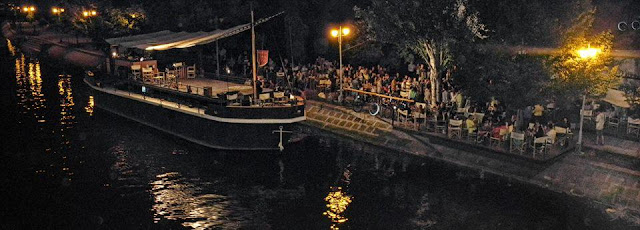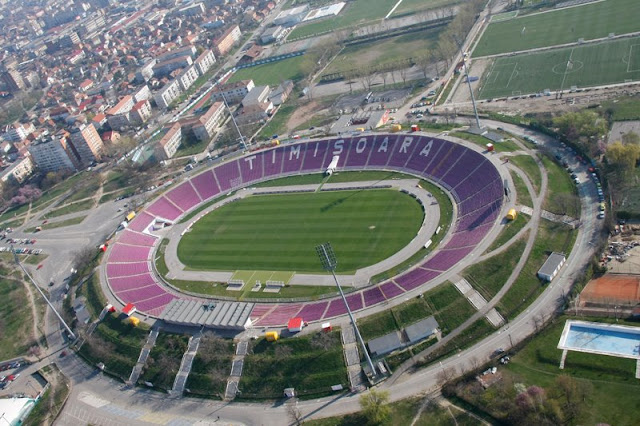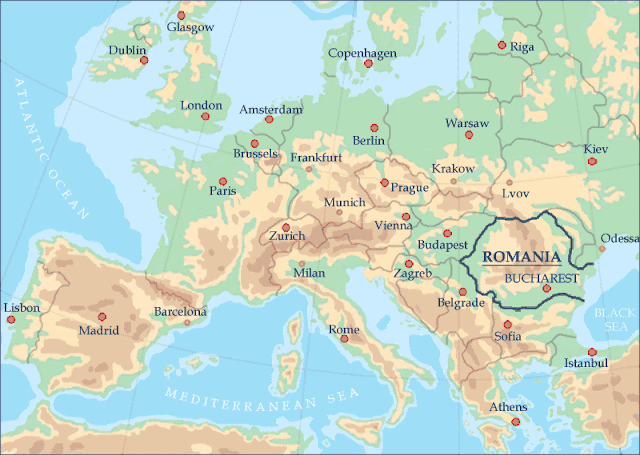Timisoara - General Information
Location: Western Romania (County: Timis)
Size: 52 sq. miles (130.5 sq. kilometers)
Elevation: 310 ft. (90 meters)
Population: 450,000
Inhabited since: 200 BC
First documented: 1212 AD
Location: Western Romania (County: Timis)
Size: 52 sq. miles (130.5 sq. kilometers)
Elevation: 310 ft. (90 meters)
Population: 450,000
Inhabited since: 200 BC
First documented: 1212 AD
Darc Café, on the shore of Bega river
Sunset on the Bega river
- A night in Timisoara -
Morning, sleeping swans on the Bega canal
(Dimineata, Lebede adormite pe Bega)
Timisoara - City Highlights
The first record of the city of Timisoara, built on the site of an ancient Roman fortress called Castrum Regium Themes, dates back to 1212.
Over the years, Timisoara, the largest city in western Romania, has been influenced by many cultures. The Romans used it as an important crossroads fortress until the Tatars destroyed it in the 13th century. Conquered by Turkish armies in 1552, Timisoara remained under their protection until 1718 when the region of Banat came under Austrian rule for two centuries. Timisoara later became a vital commercial and manufacturing town. Turks, Austrians, Germans and Serbs all left their mark and their influence can be seen in neighborhoods throughout the city even today.
The charm of this city, settled on the northern bank of the Bega River, lies in its distinct architectural character and vibrant cultural life. Frequently referred to as "Little Vienna," Timisoara is home to year-round musical and theatrical performances, art galleries, museums and a buzzing nightlife. A progressive, cosmopolitan place, Timisoara was the first city in Europe and second in the world after New York, to use electricity to illuminate its public streets.
Thanks to its mild climate, Timisoara has lots of public squares and lush green retreats. The city is easy to explore on foot. If you get tired, a tram will be along in a moment; the system is fast, frequent and efficient.
Timisoara abounds with churches of several denominations, a Jewish quarter, an elegant baroque square and a pedestrian-only downtown area. Some of the monuments in the heart of the city afford panoramic views, while the many parks in this "city of flowers" provide an idyllic spot to take a break from sightseeing.
City Landmarks
In many respects, it is the abundance of Secessionist architecture that has provided Timisoara with its rather appropriate moniker, "Little Vienna." Secessionism developed in two distinct architectural phases here. Sinuous lines and floral decorations characterized the first phase which lasted until 1908. The second phase, which continued until the First World War, saw simpler, larger buildings with geometrical designs. Secessionism in Romania was an important link between the Byzantine style and later modernist architecture.
- Victory Square (Piata Victoriei)
TIMISOARA - Lloyd Palace (Palatul Lloyd) © 2008 Antonius Plaian
- The focal point is the towering Romanian Orthodox Metropolitan Cathedral (Catedrala Ortodoxa Mitropolitana)
foto credits: Hemant Shehrawat
- Union Square (Piata Unirii)
foto credits: Cornel Alin
foto credits : Andrei Istrate
Foto : Andrei Ala
foto credits: Hemant Shehrawat
Nicolas Lenau College (Liceul Nicolas Lenau), located on the north side of the square, was built in 1761 and was home to the earliest theatre in Timisoara.
- The baroque Serbian Orthodox Cathedral (Biserica Orthodoxa Sarba),
built in 1745-48, and the mint green and white Serbian Bishop's Residence (Vicariatul Ortodox Sarb) with its extravagant decorations are located on the west side of the square. The Cathedral can be visited daily between 7am and 6pm.
foto credits: Flore Corlan
- The Roman Catholic Cathedral (Catedrala Episcopala Romano-Catolica)
foto credits: Dan Popescu
- The impressive 18th century Baroque Palace (Palatul Vechii Prefecturi)
- At the northwest corner of Piata Unirii stands the spectacular Scont Bank (Banca de Scont).
foto: Hemant Shehrawat
From Piata Unirii, walk east along Str. Palanca to the oldest building in Timisoara, now housing the Banat Etnographic Museum within the city's remaining 18th century bastion.
Curtea Bastionului Theresia, Timisoara
[ Theresia Bastion courtyard, Timisoara ]
[ Theresia Bastion courtyard, Timisoara ]
Foto : Hemant Shehrawat
Theresia Bastion, aerial photo - Photo by : Virgil Simonescu
- Freedom Square (Piata Libertatii) to Victory Square (Piata Victoriei) :
Central Park - busts of prominent personalities in the history of Timisoara (in the foreground bust Florimund Count Claudius Mercy, next to that of Eugene of Savoy)
Parcul Central - busturi ale personalitatilor marcante din istoria Timisoarei (in prim-plan bustul contelui Claudius Florimund Mercy, iar alaturi cel al lui Eugeniu de Savoia)
Christmas time in Timisoara
Christmas time in Timisoara
The beautiful historical center of Timisoara
foto: Hemant Shehrawat
foto: Hemant Shehrawat
foto : Hemant Shehrawat
Foto: Orăşteanu Roxana
Warm evening, Victory Square, Timisoara
Continue along Str. Lucian Blaga to the 14th century Huniade Castle (Castelul Huniade). Built during the rule of Carol Robert, Prince de Anjou, it was completed by Iancu of Hundeoara and redesigned by the Habsburgs in the 18th century.
Huniade Castle (Castelul Huniade)
Residential areas
South and east of the Bega Canal are the Josefin, Elisabetin and Fabric residential districts, true gems of Jugendstil, or art nouveau, architecture, built mainly in the late 19th century. The small residential square of Piata Plevnei, south of the Bega Canal, is bordered by excellent examples of the first phase of Secessionist architecture, such as Gemeinhardt's Peacock House (Casa cu Pauni) built in 1905. Facades are covered with an abundance of typical motifs: peacocks, swans, owls and squirrels together with sinuous vines and foliage. The theme continues on the buildings lining Splaiul Tudor Vladimirescu, following the south bank of the Bega, and to a lesser extent, around nearby Piata Maria and Bulevardul 16 Decembrie 1989.
Different perspective
foto : Hemant Shehrawat
Fabric neighborhood (Cartierul Fabric)
foto: Claudiu Pavlov
foto : Hemant Shehrawat
Fabric neighborhood (Cartierul Fabric)
foto: Claudiu Pavlov
Secessionist, or art nouveau architecture also can be found in the cities of Arad (especially on Strada Closca and Piata Avram Iancu), Oradea (Vulturul Negru and Astoria hotels), Cluj (Odon Lechner National Theatre), Satu Mare and Targu Mures (Palace of Culture).
- Jewish Timisoara
In the old Sephardic cemetery, graves dating to the Turkish occupation may be seen, the oldest belonging to Azriel Assael, a Rabbi and surgeon who died in 1636. A century latter, Rabbi Meir Amigo and four followers from Istanbul were allowed to settle in the city.
Following the implementation of citizen rights acts in the Austro-Hungarian Empire, Timisoara's Jewish community flourished, reaching a population of almost 7,000. Six synagogues were built in the city after 1867, the year of the Austro-Hungarian reconciliation. Today, three remain with one still active.
Synagogue in Fabric
Nearby Attractions
Recas Vineyards
Where: 12 miles east of Timisoara
Access: car, bus, train
http://www.recaswine.ro/?r=na
Taste white, red and rosé wines, such as Cabernet Sauvignon, Burgund Mare, Merlot, Cadarca, Feteasca Regala or Creata at Recas Wine Cellars (Cramele Recas). A visit at the cellars will give you the opportunity to attend a presentation of the wine making process in the Barrique Hall, and the conservation of bottled wines in the Recas vinoteque - featuring stocks of exceptional vintages.
***
Timisoara was the first European city to introduce horse-drawn trams (in 1869) and electrical street lighting (in 1889);
Timisoara was built on a swamp; the Metropolitan Cathedral has 5000 oaks supports underneath it;
Johnny Weissmuller, Hollywood's original Tarzan, was born here.
***
Timisoara was the first European city to introduce horse-drawn trams (in 1869) and electrical street lighting (in 1889);
Timisoara was built on a swamp; the Metropolitan Cathedral has 5000 oaks supports underneath it;
Johnny Weissmuller, Hollywood's original Tarzan, was born here.
***
Map of Central Europe





























































0 Yorumlar